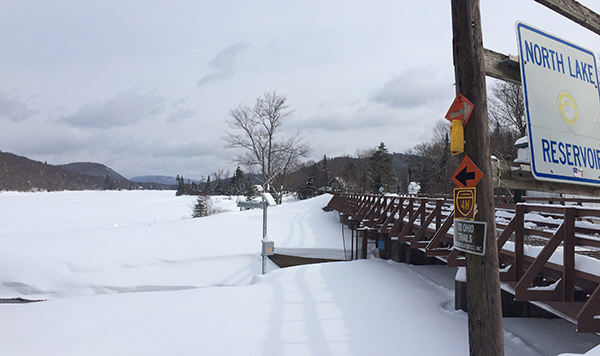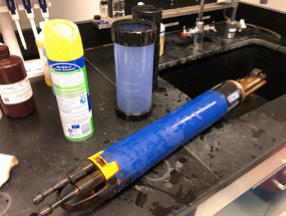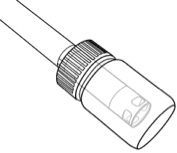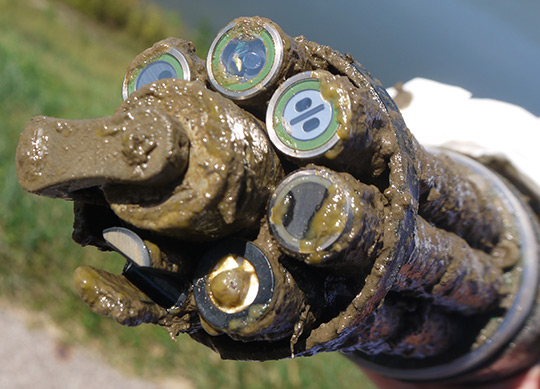How Do I Properly Store My Water Quality Instrumentation?
(Updated November 2021)
It’s that time of year again – data collection has stopped because rivers and lakes are freezing over and equipment seemingly goes into hibernation until Spring when it is safe to return outside. But what exactly is the best way to store all of that equipment for a long period of time?
Water quality instrument storage can prolong the life of your investment and make your job a lot easier when you are ready to get back into the field come springtime.

Instruments and Handhelds
The first step to complete is removing any batteries from the instrument or handheld. Then, check the battery compartment o-rings for any nicks, dry rot, pitting, or any other damage; replace these now if needed, applying a small bit of Krytox lubricant to the entire o-ring.
Also, check the battery compartment for any signs of corrosion. If any corrosion is detected, clean this corrosion away and check for any damage. If there is any damage noted, send the instrument or handheld to our repair department to make any necessary repairs. Do not reinstall the batteries into the instrument; this will prevent any battery leaks from damaging the instrument.
Next, clean the instrument completely following procedures found in the instrument’s manual, ensuring that all communication ports and any empty sensor ports are capped or plugged. If there is hard to remove debris still on the instrument, it may need to be soaked overnight in soap and water or a diluted vinegar solution, again ensuring that connectors and ports are capped or plugged before performing this step. After the cleaning or soak, remove the sensors and allow the instrument to dry but not the sensors (sensors will be discussed in the next section). Check the instrument after it has been cleaned, including looking at all of the connector pins, for any signs of damage or wear.
If there is hard to remove debris still on the instrument, it may need to be soaked overnight in soap and water or a diluted vinegar solution, again ensuring that connectors and ports are capped or plugged before performing this step. After the cleaning or soak, remove the sensors and allow the instrument to dry but not the sensors (sensors will be discussed in the next section). Check the instrument after it has been cleaned, including looking at all of the connector pins, for any signs of damage or wear.
Depending on the types of sensors that are normally connected to the sonde, storage of the instrument will vary. Some sensors require that they be stored in a solution and some can be stored dry. These details will be discussed below and decisions can then be made on proper storage.
Sensors
Each of the sensors has a particular storage need but they all share a common need of being cleaned and inspected before being stored. The sensors can all be cleaned using soap and water and gently scrubbed. If they need to be soaked to remove additional contamination, it is recommended that they be attached to the sonde for this soaking to protect the connectors. Additional cleaning requirements can be found in the manual for the particular instrument and will not be detailed here. After thoroughly cleaning the sensors, follow the below storage procedures to ensure that the sensors will be ready for the next monitoring season:
Temperature/Conductance, Turbidity, Total Algae, and FDOM
These sensors can either be stored wet or dry. If the sensor is not going to be attached to an instrument, attach the sensor connector cap that came with the sensor. Store the sensor in an airtight container. If the sensor is going to remain attached to the instrument, it is safe to store this sensor in any solution that the other sensors will require. If the only sensors attached to the instrument are fine being stored dry, simply attach the guard and dry calibration cup and store in an airtight container, instrument carrying case, or dry location out of sunlight.
pH/ORP
 This sensor should not ever be stored dry. It is recommended that this sensor is removed from the instrument and stored in the storage container that it was originally shipped in. The storage medium that should be inside the container is a pH 4 solution. Ensure periodically over the winter season that there is still solution inside the container and refill as necessary. If the sensor does accidentally go dry, there is a rehydration procedure in the manual but know that the sensor may be irreparably damaged. The sensors should be stored upright in their storage container in a location out of direct sunlight to limit as much evaporation as possible.
This sensor should not ever be stored dry. It is recommended that this sensor is removed from the instrument and stored in the storage container that it was originally shipped in. The storage medium that should be inside the container is a pH 4 solution. Ensure periodically over the winter season that there is still solution inside the container and refill as necessary. If the sensor does accidentally go dry, there is a rehydration procedure in the manual but know that the sensor may be irreparably damaged. The sensors should be stored upright in their storage container in a location out of direct sunlight to limit as much evaporation as possible.
Dissolved Oxygen
T his sensor should also never be stored dry. Ideally, this sensor should remain attached to the instrument that it is normally connected to. The calibration cup should then be filled with water, sensor submerged, and the calibration cup tightened to the instrument preventing as much evaporation as possible. The instrument should then be stored in a secure location on its end, ensuring that the sensor is submerged in water at all times. Periodically check on these sensors to ensure that they remain wet throughout the winter as well and refilling the cup as needed. If the environment does go dry, there is a rehydration step in the instrument's manual but know that the sensor gain may be affected compared to that recorded before the storage period.
his sensor should also never be stored dry. Ideally, this sensor should remain attached to the instrument that it is normally connected to. The calibration cup should then be filled with water, sensor submerged, and the calibration cup tightened to the instrument preventing as much evaporation as possible. The instrument should then be stored in a secure location on its end, ensuring that the sensor is submerged in water at all times. Periodically check on these sensors to ensure that they remain wet throughout the winter as well and refilling the cup as needed. If the environment does go dry, there is a rehydration step in the instrument's manual but know that the sensor gain may be affected compared to that recorded before the storage period.
If using a polarographic or galvanic sensor, this sensor should always be stored dry for long-term storage (>30 days). The membrane cap should be removed from the instrument and the whole sensor should be cleaned with fresh water. Then, it should be dried completely and a new membrane cap should be installed over the dry electrodes simply to protect them. Be aware that this storage membrane cap is not the one that will be used for field sampling – a new membrane cap with electrolyte solution will need to be installed before field use.
ISEs
Ion Selective Electrodes should not ever be stored dry nor should they be completely submerged. These sensors should be removed from the instrument and stored in the storage containers that they were shipped in. The storage medium that should be inside the container should be plain tap water. It is very important that these sensors are not stored in conductivity standard, pH buffer, saltwater, or any other medium with significant conductivity as these will damage the sensors. Ensure periodically over the winter season that there is still solution inside the container and refill as necessary. If the sensor does accidentally go dry, there is a rehydration procedure in the manual but know that the sensor may be irreparably damaged. The sensors should be stored upright in their storage container in a location out of direct sunlight to limit as much evaporation as possible.
Central Wiper
It is also important during this time of year that your central wiper gets some well-deserved attention! We recommend an annual servicing of the central wiper to replace the o-ring inside of the sensor that cannot be changed outside of a repair center.

The central wiper is a work horse to prevent fouling during the field season so make sure it's taken care of!
Cables
The maintenance for field cables that connect to the handheld devices is straightforward to care for.
The first step in preparing the cables for storage is to clean off any debris from the length of the cable and verify that the integrity of the cable is still intact by checking the length for any damage. Like all cables, they are the most vulnerable to damage at the connectors, so this is where the majority of the attention should be focused. The connectors should be inspected thoroughly for any nicks or tears and all contamination should be removed using soap and water.
A thin layer of Krytox grease should be applied to the connectors to keep them from drying out and cracking once they are stored. Once the cable is dry, if the cable can remain attached to the instrument and handheld that it is normally paired with, that is ideal; then, place the assembly inside an airtight storage container out of direct sunlight. However, if that is not possible, attach the connector storage caps that the cable was initially shipped with to either end of the cable over the connectors and place the cable in an airtight storage container out of direct sunlight.
Flying lead cables are either left out in the field over the winter season or are completely pulled from the site for storage in the laboratory with the rest of the instrumentation.
If the cable cannot be removed from the field, first check the exposed portion of the cable for any damage and clean off any contamination. On the end of the cable that may be exposed to moisture, attach the storage cap that was initially shipped with the cable and completely wrap this end with electrical tape to keep excess moisture out. If using a vented flying lead cable, replace the old desiccant with fresh and cap the end of the cable to keep the tube dry.
If the cable is able to be removed from the field, check the entire length for damage and clean off any contamination and debris using soap and water. Apply a slight bit of Krytox grease to the connector that would normally attach to the sonde and then place the red storage cap on the end. The exposed wires on the other end should be bundled together and wrapped either with bubble wrap or electrical tape to keep these ends from being damaged. Once the cable is dry, it should then be placed into an airtight storage container and kept out of sunlight. If it is a vented flying lead cable, the desiccant should be replaced with fresh desiccant and the ends of the cable should be capped. The entire cable should then be placed into an airtight container and surrounded by desiccant to ensure that no moist air can enter the cable.
By following the above recommendations for storing your sondes, sensors, and cables, your instrumentation will be safe and secure all winter long and ready for its next deployment come Spring! If you need additional assistance, please be sure to reach out to our tech support team by calling +1 937-767-2762 or by e-mailing info@ysi.com.

Additional Blog Posts of Interest
5 Tips to Prevent Costly Mistakes with Your Water Quality Sonde
7 Tips to Fight Fouling and Extend Water Quality Sonde Deployments
Get Your Water Quality Sonde Ready for the Field Season
How to Take Care of Your New EXO Sonde